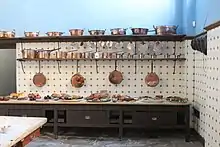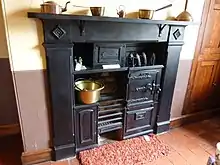Jenny Kenna
Jenny Kenna is a director, actress and writer from South Wales.
Jenny Kenna | |
|---|---|
| Born | Ferryside, Wales |
| Culinary career | |
| Cooking style | Welsh cuisine |
| Website | https://www.facebook.com/jenny.kenna.127 |
Career
Kenna appeared in a number of British television sitcoms, game shows and musicals during the 1970s and 80s.
Kenna's parents were from Ferryside, Carmarthenshire and in 2002 she returned there from Notting Hill after retiring from acting. [1][2]
Kenna wrote and directed the television series Windfalls (1987) and was one of the actors appearing in the BBC sitcom Are You Being Served?. Kenna appeared in Series 5 ("Founder's Day") as the customer called "Fake Secretary/Miss 38-22-36". Kenna also appeared in The Les Dawson Show and also appeared in English and German versions of The Generation Game.
In 1978 Kenna also performed in the Jubilee Edition of The Good Old Days (British TV series). This television series re-created Music Hall variety shows that were popular in the late Victorian and the Edwardian periods.[3]
Writing
Kenna has written two books on Welsh cuisine. In 2009 Kenna wrote the book Susan's Secrets, A Victorian Kitchen in Wales. According to Kenna, this book is based on her grandmother's hand-written cookery notebook:[4]
I found my grandmother's handwritten notebook, dating back to the end of the nineteenth century, among family papers in a battered old suitcase. The well-worn little book contains more than 70 recipes, and several poems.
Kenna's grandmother was Susan Elizabeth Webb who came from Johnston, Pembrokeshire and was born in 1877. She worked for a local solicitor called Owen Mansel Bryant who lived in a Georgian house on Main Street in Pembroke and then moved to Morfa Terrace, Manorbier. She began work as a kitchen maid and then worked as a cook.[5]

Kenna comments that:[6]
Most of the recipes in her notebook are for cakes and desserts, because during her training this type of cookery would have been her initiation to the more complicated dishes she would prepare later.
When I discovered my grandmother's recipes I immediately began to try them out and to my delight they all worked deliciously well. There seemed something very personal and poignant in making the dishes from these recipes that grandmother prepared all those years ago: it was almost like eating history, the taste of the past.
Kenna notes that the working day of a cook in the early twentieth century was long and hard:[7]
The work was extremely hard. Susan started at 6am. The first task was to prepare the kitchen range. This was made of cast iron with two ovens at either side with an enclosed fire in the middle and hot plates on top. Each morning the remains of the previous day's fire had to be raked through and a new one prepared and lit. Pans and kettles were filled with water from the pump outside the kitchen door and placed on the hot plates to heat. The hot water for the family's morning wash was carried upstairs in special containers. Once a week the huge range had to be cleaned with blacking. Servants had many tasks – sewing, shoe-cleaning, washing dishes, laundering and ironing and scrubbing the front step.
Food preparation was done on a large central wooden table that was cleaned after each use and scrupulously scrubbed down at the end of the day. There were few labour saving devices and cooking was a tiring, physical job. Many of Susan's recipes required ingredients to be mixed for at least half an hour.
By the early 1900s modern conveniences were being introduced into the home and Kenna notes how this made the life of a cook easier:[8]
....the gradual availability of new ingredients and food processes tended to ease the strain. Margarine and factory-produced sausages had already been introduced in 1870 and, ten years before, powdered and evaporated milk was developed. Tinned foods were becoming available and citrus fruits, bananas and spices were more plentiful.
In 2012, Kenna went on to write Quaking Pudding, A Georgian Kitchen in Wales and recounted as follows:[9]
I had no sooner finished my last book....when I found, quite by chance, another remarkable old treasure – an original copy of The London Art of Cookery by John Farley, published in 1807.
This precious book belonged to Anne Allen, my husband's great-grandmother. I discovered it, carefully wrapped in tissue paper, in the home of my late sister-in-law. I was captivated, and particularly curious to learn more about the Allen family. And I wanted to explore the possibility of reproducing some of the recipes in this old book.
Kenna went on to explain how she re-cast the recipes:[10]
I had to decipher some of the cookery terms. Collops (small slices), sippets (small slices of toast), codlins (un-ripened apples), eschalets (shallots), cullis (stock), cod sounds (bladders on the spines of cod), lamb stones (testicles), and neat's tongue (ox tongue), were part of the culinary vocabulary. I was curious about a Stubble Goose recipe, and discovered that the birds used were fed on the stubble left after harvesting.
Kenna explains that, despite its great detail and complex instructions, the book contains 'a cornucopia of delicious recipes'. Kenna tested the recipes on a number of testers and tasters, including Stan Stennett, Dave Gelly and Martyn Joseph.

Kenna also discovered that her husband's great aunt had written a biography entitled Obscure People and from it she learned that the family ran a confectionary and catering business in Duke Street, Cardiff which was recorded in Slater's Commercial Directory as trading until around 1859. They had used The London Art of Cookery for their business and Kenna selected recipes from it and adapted them for contemporary use and renamed some of the recipes. Describing the Cardiff shop, Kenna recounts:[11]
Inside were huge selections of sumptuous cakes in all shapes and sizes. Assorted biscuits such as langues de chat and madeleines were arranged along the counters in eye-catching glass jars. White tins with tempting gold inscriptions – meringues, pistachio cakes, macaroons, aniseed biscuits – lined the shelves. There were rows of jams, and yet more jars of calves foot jelly, aspic jelly, mulberry jelly and damson cheese.
People came from all over South Wales at Christmas to admire the elaborate window display of spectacularly decorated cakes, with lacy iced piping and marzipan flowers, and other festive delights.

The family prepared the banquets for the 'fabulously rich Bute family of Cardiff Castle' and the shop was located nearby. [12] The shop also provided gallons of bouillon, oyster and chicken patties, and puff paste for the Glamorgan Hunt Ball. It also supplied Lady Wynne-Watkins with syllabubs, riband jellies, steeple creams, tipsy cakes marbled biscuits, and water ices.[13] Kenna notes that the wealthy 'entertained on a grand scale' while 'the poor relied on potatoes, carrots, turnips and cabbage and the occasional cheap cut of meat'. On the diet of the rich Kenna comments:[14]
The wealthy ate huge meals with many courses. Their diet was unhealthy, rich in salt, sugar and fat and alcohol. Expensive vegetables, such as asparagus, artichokes and celery, were served with melted butter sauce. Breakfast was hearty – sweet porridge, grilled meats, sausages, kippers, bacon and eggs, cakes, rolls and toast.
.jpg.webp)
Kenna comments that old notebooks and texts, like the ones she has used for her books, give a valuable insight into the ways of life and eating habits of earlier times and that they also were the beginning of today's cookery books.[15]
Bibliography
Kenna has written two cookery books and a craft book for children:
- Quaking Pudding - A Georgian Kitchen in Wales (2012) ISBN 0954982827
- Susan's Secrets - a Victorian Kitchen in Wales (2009) ISBN 0954982819
- Crafty Leaves (2014) ISBN 0954982835
References
- "Jenny Kenna 'I appeared on German TV with £1,000 stuffed down my bra!': An actress' life on 1970s TV".
- "Susan's Secrets".
- "IMD bio, Jenny Kenna".
- Kenna, J: Susan's Secrets, A Victorian Kitchen in Wales, page (iii). Ceiniog Press, 2009. ISBN 978-0-9549828-1-2
- Kenna, Susan's Secrets, A Victorian Kitchen in Wales, page (iii), (v).
- Kenna, Susan's Secrets, A Victorian Kitchen in Wales, page (iii), (v).
- Kenna, Susan's Secrets, A Victorian Kitchen in Wales, page (v), (vi)
- Kenna, Susan's Secrets, A Victorian Kitchen in Wales, page (vii).
- Kenna, J: Quaking Pudding, A Georgian Kitchen in Wales, page (iii). Ceiniog Press, 2012. ISBN 978-0-9549828-2-9
- Kenna, Quaking Pudding, A Georgian Kitchen in Wales, pages (xiii)-(xvii).
- Kenna, Quaking Pudding, A Georgian Kitchen in Wales, page (vi).
- Kenna, Quaking Pudding, A Georgian Kitchen in Wales, pages (viii).
- Kenna, Quaking Pudding, A Georgian Kitchen in Wales, page (x).
- Kenna, Quaking Pudding, A Georgian Kitchen in Wales, pages (xiv).
- Kenna, Susan's Secrets, A Victorian Kitchen in Wales, page (xiii).